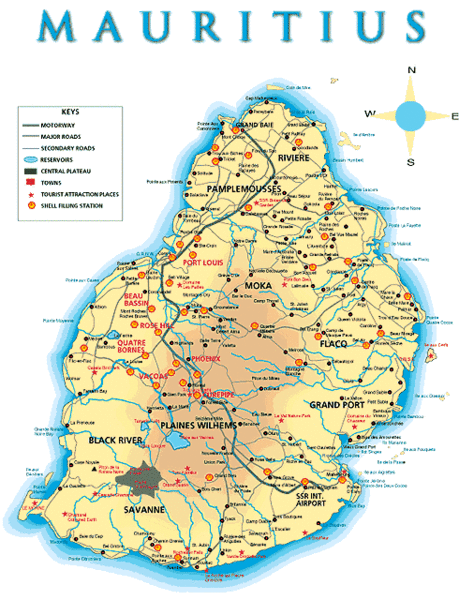Mauritius
Area 788 square mi (2,040 square km)
Population 1.261 million 2014
Capital Port Louis
Highest Point 2,732 ft (828 m)
Lowest Point 0 m
GDP $12.62 billion 2014
Primary Natural Resources arable land, sugarcane, tea, cattle, goats, fish.
MAURITIUS IS AN island nation in the INDIAN OCEAN, located about 500 mi (800 km) east of MADAGASCAR. Governed by successions of Dutch, French, and British colonial administrations, and settled with workers from East Africa, INDIA, and CHINA, Mauritius today is an interesting hodgepodge of these various elements in everything from language to culture to politics. More economically and politically stable than some of its island neighbors, with one of the highest per capita incomes in the developing world, it is a leader in the Indian Ocean Rim Association, and maintains strong ties with several east African, Arab, and Far Eastern nations.

The country of Mauritius includes the main island, plus Rodrigues Island (372 mi or 600 km to the east) and the much smaller (and much farther away) Agalega Islands and Cargados Carajos Shoals to the north. Together with the island of Reunion (an overseas department of FRANCE), Mauritius and Rodrigues are collectively called the Mascarene Islands. The islands to the north are very small and unpopulated, but they form a key part of Mauritius's claims to an EEZ (exclusive economic zone) covering 468,000 square mi (1.2 million square km) of the Indian Ocean off the coast of Africa.
There are tensions over claims put forward over Tromelin Island to the northwest (held by France) and Diego Garcia far to the northeast (1,197 mi or 1,931 km) in the Chagos Archipelago (held by the UNITED KINGDOM).
The islands are in an area of geologic activity. The Mid-Indian Ocean Ridge lies 200 mi (320 km) to the east, with the Rodrigues fracture zone and the Mauritius Trench as perpendicular offshoots. Mauritius is of relatively recent volcanic origin, about 12 million years, but has been dormant for the last 100,000 years. It is formed of a ring of mountains (about 18 percent of the land area) encircling a central plateau with a smaller coastal plain. Rodrigues is of similar volcanic formation, but in a ridge running west to east, and much younger (about 1.5 million years). Both are ringed by coral reefs. The smaller islands are not volcanic, but coralline, and are home to coconut palms and fishing boats.
The islands' tropical climate and position along southeast trade winds attracted Arab and Malay traders, followed by Portuguese explorers, who named the main island Ilha do Cirne (“island of the swan”) early in the 16th century—possibly for the native population of large flightless birds called dodos. The Dutch attempted settlements and plantations twice in the 17th century. Neither attempt took root, but the island's new name did—Mauritius, named for Maurits van Nassau of Holland—as did their environmental impact, that is, the extinction of the dodo, the introduction of rats, and the replacement of much of the native ebony forests with sugarcane. The French East India Company claimed the island in 1715, having already begun settlements on Rodrigues and Bourbon (today's Reunion). Port-Louis was an important center for trade, privateering, and naval operations against the British, and French planters grew very rich on the backs of African slave labor.
The British took the islands in 1810 and retained the colony after the 1814 settlements ended the Napoleonic Wars back in Europe, but most of the French sugar planters stayed on. The small number of English settlers meant that Mauritius retained much of its French culture, and many people today speak a French patois (mixture). With the abolition of slavery in 1834, the British imported indentured workers from India in vast numbers; they made up about two-thirds of the population by 1870.
Today, the descendants of South Asians continue to outnumber the descendants of freed African slaves (Creoles) and the small numbers of people of Chinese and European origin. Tensions between these groups have largely been settled since independence from the United Kingdom in 1968.
The economy was almost entirely sugar-based until recently, but is now being diversified into production of textiles, chemicals, and other light industry, plus the encouragement of tourism. It remains a member of the Commonwealth, but became a republic in 1992. Population density on Mauritius is one of the highest in the world, while only 36,000 people live on Rodrigues.